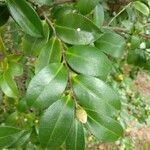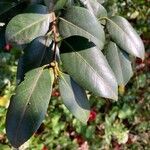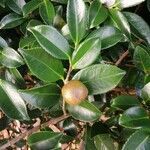Shrubs or trees, 1.5-6(-11) m tall. Young branches grayish brown; current year branchlets purplish brown, glabrous. Petiole 5-10 mm, glabrous or adaxially pubescent; leaf blade broadly elliptic, elliptic, or oblong-elliptic, 5-10.5(-12) × 2.5-6(-7) cm, leathery, abaxially pale green and brown glandular punctate, adaxially dark green, both surfaces glabrous, midvein yellowish green, thick, and elevated on both surfaces, secondary veins 6-9 on each side of midvein, slender, and visible on both surfaces, base cuneate to broadly cuneate, margin serrulate, apex shortly acuminate and with an obtuse tip. Flowers axillary or subterminal, solitary or paired, 6-10 cm in diam., subsessile. Bracteoles and sepals ca. 9, green at anthesis; outer 4 bracteoles and sepals lunate to semiorbicular, 2-5 mm, glabrous, subglabrous, or grayish white velutinous; inner bracteoles and sepals green, persistent to young fruit, orbicular to broadly ovate, 1-2 cm, thinly leathery, both surfaces grayish white velutinous or subglabrous, margin membranous. Petals 6 or 7 but often more for cultivars, rose or white, obovate to broadly obovate, 3-4.5 × 1.5-2.5 cm, apex emarginate; inner 5 petals basally connate for 0.5-1.5 cm. Stamens 2.5-3.5 cm, glabrous; outer filament whorl basally connate for 1.5-2.5 cm. Gynoecium ca. 3 cm, glabrous. Ovary ovoid, 3-loculed; style ca. 2.8 cm, apically 3-lobed. Capsule globose, 2.5-4.5 cm in diam., 3-loculed with 1 or 2 seeds per locule; pericarp 5-8 mm thick when dry, woody. Seeds brown, semiglobose to globose, 1-2 cm in diam., glabrous. Fl. Jan-Mar, fr. Sep-Oct. 2n = 30, 45, 75.
More
A shrub or small tree. It grows 1.8-7.5 m tall. It spreads 1.8-6 m wide. The leaves are glossy on the top surface and dull and spotted underneath. They are broadly oval and pointed. The flowers are large and red. The fruit vary in size. Many named varieties occur.










